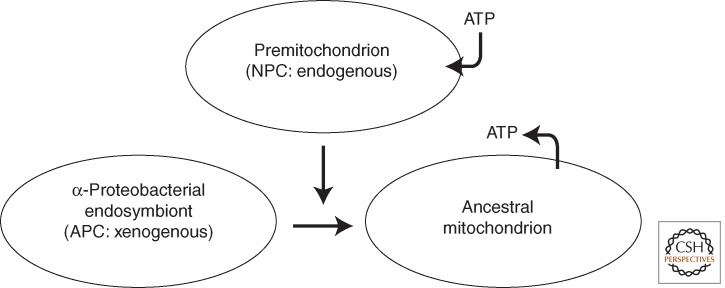Figure 2.
A schematic view of the pre-endosymbiont hypothesis. The premitochondrion is seen as a membrane-bound entity endowed with a protein import system and various ion/small-molecule transporters, compartmentalizing many of the metabolic functions of the mitochondrion. The premitochondrion is assumed to have evolved endogenously within the pre-eukaryote cell from proteins that now constitute a major portion of the NPC (non-α-proteobacterial component) of the contemporary mitochondrial proteome. An α-proteobacteria-like endosymbiont is converted to the ancestral mitochondrion, effectively “capturing” the protein components and functions of the premitochondrion. The endosymbiont contributes the APC (α-proteobacterial component) of the mitochondrial proteome, which is largely directed toward specification of energy-generating capacity (in the form of coupled electron transfer/oxidative phosphorylation). The premitochondrion → ancestral mitochondrion conversion is greatly facilitated by the existence of the reservoir of premitochondrial proteins in the host cell. Endosymbiont-to-nucleus gene transfer (EGT) coupled with rationalization of redundant pathways results in the formation of evolutionarily chimeric enzymatic pathways and protein complexes in the ancestral mitochondrion, as well as functional relocation of the products of some transferred α-proteobacterial genes to other cellular compartments. The premitochondrion is assumed to be a non-energy-generating organelle that imports ATP; a key innovation in the transition to the contemporary mitochondrion is the generation/acquisition of an ADP/ATP transporter that reverses this flow, ultimately allowing the mitochondrion to become the primary site of ATP generation for cellular functions.

